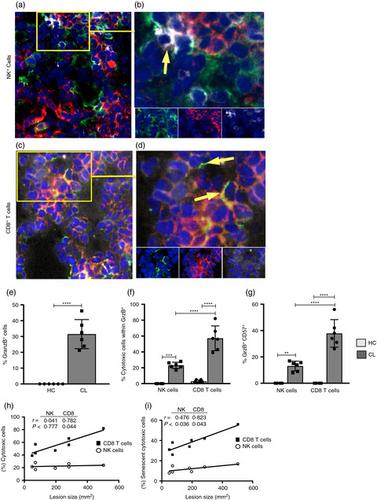当前位置:
X-MOL 学术
›
Immunology
›
论文详情
Our official English website, www.x-mol.net, welcomes your
feedback! (Note: you will need to create a separate account there.)
Compartmentalized cytotoxic immune response leads to distinct pathogenic roles of natural killer and senescent CD8+ T cells in human cutaneous leishmaniasis.
Immunology ( IF 4.9 ) Pub Date : 2020-01-26 , DOI: 10.1111/imm.13173 Luciana Polaco Covre 1 , Oliver Patrick Devine 2 , Renan Garcia de Moura 1 , Milica Vukmanovic-Stejic 2 , Reynaldo Dietze 1, 3 , Rodrigo Ribeiro-Rodrigues 1 , Herbert Leonel de Matos Guedes 4, 5 , Raphael Lubiana Zanotti 6 , Aloisio Falqueto 7 , Arne N Akbar 2 , Daniel Claudio Oliveira Gomes 1, 8
Immunology ( IF 4.9 ) Pub Date : 2020-01-26 , DOI: 10.1111/imm.13173 Luciana Polaco Covre 1 , Oliver Patrick Devine 2 , Renan Garcia de Moura 1 , Milica Vukmanovic-Stejic 2 , Reynaldo Dietze 1, 3 , Rodrigo Ribeiro-Rodrigues 1 , Herbert Leonel de Matos Guedes 4, 5 , Raphael Lubiana Zanotti 6 , Aloisio Falqueto 7 , Arne N Akbar 2 , Daniel Claudio Oliveira Gomes 1, 8
Affiliation

|
Cytotoxic activity mediated by CD8+ T cells is the main signature of the immunopathogenesis of cutaneous leishmaniasis (CL). Here, we performed a broad evaluation of natural killer (NK) cell phenotypic and functional features during cutaneous leishmaniasis. We demonstrate for the first time that CL patients present the accumulation of circulating NK cells with multiple features of replicative senescence including low proliferative capacity and shorter telomeres, elevated expression of CD57, KLRG1 but diminished CD27 stimulatory receptor expression. Moreover, they exhibited higher cytotoxic and inflammatory potential than age-matched controls. The accumulation of circulating senescent NK cells (CD56dim CD57bright ) correlated positively with skin lesion size in the same patients, suggesting that they, like circulating senescent CD8+ T cells, may contribute to the immunopathology of CL. However, this senescent population had lower cutaneous lymphocyte antigen expression and so had diminished skin-homing potential compared with total or senescent CD8+ T cells. This was confirmed in CL skin lesions where we found a predominance of CD8+ T cells (both senescent and non-senescent) that correlated with the severity of the disease. Although there was also a correlation between the proportions of senescent NK cells (CD56+ CD57+ ) in the skin and lesion size, this was less evident. Collectively our results demonstrate first-hand that senescent cytotoxic cells may mediate skin pathology during human cutaneous leishmaniasis. However, as senescent cytotoxic CD8+ T cells predominate in the skin lesions, they may have a greater role than NK cells in mediating the non-specific skin damage in CL.
中文翻译:

分区的细胞毒性免疫反应导致人类皮肤利什曼病中自然杀伤和衰老的CD8 + T细胞具有独特的致病作用。
CD8 + T细胞介导的细胞毒活性是皮肤利什曼病(CL)免疫发病机制的主要特征。在这里,我们对皮肤利什曼病期间的自然杀伤(NK)细胞表型和功能特征进行了广泛的评估。我们首次证明CL患者表现出循环NK细胞的积累,具有复制衰老的多个特征,包括低增殖能力和较短的端粒,CD57,KLRG1表达升高但CD27刺激受体表达减少。而且,它们显示出比年龄匹配的对照更高的细胞毒性和炎性潜力。循环衰老的NK细胞(CD56dim CD57bright)的积聚与同一患者的皮肤病变大小呈正相关,表明它们像循环衰老的CD8 + T细胞一样,可能与CL的免疫病理有关。但是,与总的或衰老的CD8 + T细胞相比,该衰老人群的皮肤淋巴细胞抗原表达较低,因此皮肤归巢的潜力降低。在CL皮肤病变中证实了这一点,在CL皮肤病变中我们发现与疾病严重程度相关的主要CD8 + T细胞(衰老和非衰老)。尽管皮肤中衰老的NK细胞(CD56 + CD57 +)的比例与病变大小之间也存在相关性,但这并不明显。总的来说,我们的结果证明了衰老的细胞毒性细胞可能在人类皮肤利什曼病的过程中介导皮肤病理。但是,由于衰老的细胞毒性CD8 + T细胞在皮肤病变中占主导地位,因此它们在介导CL中非特异性皮肤损伤方面比NK细胞具有更大的作用。
更新日期:2020-03-26
中文翻译:

分区的细胞毒性免疫反应导致人类皮肤利什曼病中自然杀伤和衰老的CD8 + T细胞具有独特的致病作用。
CD8 + T细胞介导的细胞毒活性是皮肤利什曼病(CL)免疫发病机制的主要特征。在这里,我们对皮肤利什曼病期间的自然杀伤(NK)细胞表型和功能特征进行了广泛的评估。我们首次证明CL患者表现出循环NK细胞的积累,具有复制衰老的多个特征,包括低增殖能力和较短的端粒,CD57,KLRG1表达升高但CD27刺激受体表达减少。而且,它们显示出比年龄匹配的对照更高的细胞毒性和炎性潜力。循环衰老的NK细胞(CD56dim CD57bright)的积聚与同一患者的皮肤病变大小呈正相关,表明它们像循环衰老的CD8 + T细胞一样,可能与CL的免疫病理有关。但是,与总的或衰老的CD8 + T细胞相比,该衰老人群的皮肤淋巴细胞抗原表达较低,因此皮肤归巢的潜力降低。在CL皮肤病变中证实了这一点,在CL皮肤病变中我们发现与疾病严重程度相关的主要CD8 + T细胞(衰老和非衰老)。尽管皮肤中衰老的NK细胞(CD56 + CD57 +)的比例与病变大小之间也存在相关性,但这并不明显。总的来说,我们的结果证明了衰老的细胞毒性细胞可能在人类皮肤利什曼病的过程中介导皮肤病理。但是,由于衰老的细胞毒性CD8 + T细胞在皮肤病变中占主导地位,因此它们在介导CL中非特异性皮肤损伤方面比NK细胞具有更大的作用。











































 京公网安备 11010802027423号
京公网安备 11010802027423号